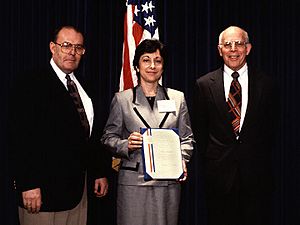John H. Gibbons (scientist) facts for kids
Quick facts for kids
Jack Gibbons
|
|
|---|---|

Gibbons (right)
|
|
| 6th Director of the Office of Science and Technology Policy | |
| In office January 20, 1993 – April 3, 1998 |
|
| President | Bill Clinton |
| Preceded by | D. Allan Bromley |
| Succeeded by | Kerri-Ann Jones (acting) |
| Personal details | |
| Born | January 15, 1929 Harrisonburg, Virginia, U.S. |
| Died | July 17, 2015 (aged 86) Crozet, Virginia, U.S. |
| Education | Randolph-Macon College (BS) Duke University (MS, PhD) |
| Scientific career | |
| Institutions | Oak Ridge National Laboratory University of Tennessee Office of Technology Assessment |
| Thesis | High resolution measurements of neutron cross-sections (1954) |
| Doctoral advisor | Henry W. Newson |
John Howard "Jack" Gibbons (born January 15, 1929 – died July 17, 2015) was an American scientist. He was a nuclear physicist and a well-known expert in how to use technology to save energy. He also knew a lot about protecting our natural resources. From 1993 to 1998, he worked for President Bill Clinton as his main science advisor. He was also the Director of the White House Office of Science and Technology Policy.
Contents
Jack Gibbons' Education
Jack Gibbons went to Randolph-Macon College. In 1949, he earned two bachelor's degrees there. One was in mathematics and the other in chemistry. Later, in 1954, he received his doctorate degree in nuclear physics from Duke University.
Jack Gibbons' Career in Science and Government
After finishing his studies, Dr. Gibbons worked for 15 years at Oak Ridge National Laboratory. There, he studied the inside of atoms. He focused on how neutron capture helps create heavy elements in stars. In the late 1960s, he started looking into ways technology could help save energy. He also studied how to reduce the harm that energy production does to the environment.
In 1973, Dr. Gibbons became the first Director of the U.S. Federal Office of Energy Conservation. This office worked to find ways for the country to use less energy. In 1975, he moved back to Tennessee. He then led the Energy, Environment and Resources Center at the University of Tennessee.
In 1979, Dr. Gibbons was chosen to lead the U.S. Congressional Office of Technology Assessment (OTA). The OTA gave the Congress clear and unbiased information. This information was about how technology affects public policy. He led the OTA for over 12 years, until 1992.
President Bill Clinton asked Gibbons to be his Assistant for Science and Technology. He also became the Director of the White House Office of Science and Technology Policy. He held these important jobs from 1993 to 1998. As the President's Science Advisor, he helped lead a special committee. This committee advised the President on science and technology. He was also part of several other important government groups. These groups helped coordinate science and technology plans across the government.
After working at the White House, Dr. Gibbons continued to share his knowledge. He taught at MIT from 1998 to 1999. He also worked at the National Academy of Engineering. There, he helped with new programs about Earth systems. From 1999 to 2001, he advised the U.S. Department of State. He helped them improve their science and technology efforts.
Awards and Memberships
Between 1994 and 1997, Dr. Gibbons received five honorary doctorates. These were special degrees given by universities like Duke University.
Dr. Gibbons was a member of many important scientific groups. He was a fellow of the American Physical Society. He was also a fellow of the American Association for the Advancement of Science (AAAS). He was chosen to be a member of the National Academy of Engineering. He also belonged to the American Philosophical Society and the American Academy of Arts and Sciences.
He received several major awards for his work. He won the AAAS Philip Hauge Abelson Prize for his great contributions to science. He also received the Leo Szilard Award for using physics to help the public. The governments of Germany and France gave him medals. These were for helping scientists from different countries work together. Dr. Gibbons wrote over 50 papers about energy and environmental policy.
From 2000 to 2001, he was the elected President of Sigma Xi, a scientific research society. In 2004, he helped start Scientists and Engineers for America. This group works to promote good science in the U.S. government. He was also a member of the Council on Foreign Relations and the Federation of American Scientists.
In 2005, he received the George Brown Award. This was the highest award from the US Civilian Research and Development Foundation. It honored his work in international science and technology cooperation.
Tributes to Jack Gibbons
Former Vice President Al Gore spoke about Dr. Gibbons after he passed away. He said he was very sad to hear the news. Gore remembered working with Jack Gibbons in Congress. He said Gibbons had a special ability to understand big issues. He could look at problems affecting our planet using science, technology, and ethics. This helped leaders make better decisions and prepare for the future. Gore said Jack's positive attitude and imagination helped the U.S. deal with tough issues, like climate change.
Jack Gibbons' Personal Life
Jack Gibbons was born in Harrisonburg, Virginia, in 1929. As a teenager, he became an Eagle Scout. This is the highest rank in the Boy Scouts. He also earned the Order of the Arrow. In 1955, Gibbons married Mary Ann Hobart. They had three children: Virginia Neil, Diana Conrad, and Mary Marshall. For many years, they lived in The Plains, Virginia. Jack Gibbons passed away in 2015 in Crozet, Virginia, after having a stroke. His brother, William Conrad Gibbons, who was a historian, also passed away in 2015.

